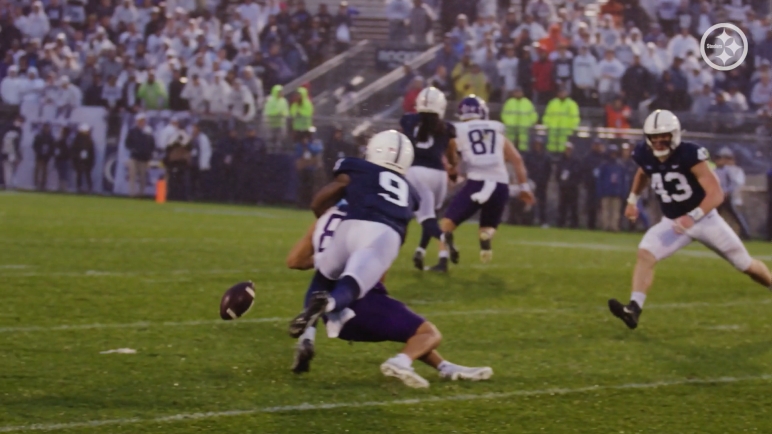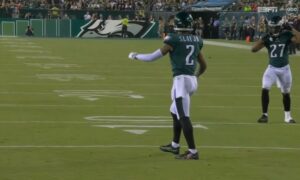Joey Porter Jr. ‘s length and press-coverage profile make him an attractive fit in Pittsburgh, which deploys Cover 1 at a rate matched by few other teams across the league. Likewise, much of the dialogue and coverage following the Porter selection, including my prior article, covers his ability in press.
In that respect, it is equally important to highlight the strengths and weaknesses of other aspects of his game, namely his work in off-man and zone coverages, the subject of this article. While press coverage is far more prevalent at the collegiate level, off-man coverage remains an important skill among top corners at the NFL level. It creates opportunities to play the sticks, key the quick game, and take calculated risks to jump passing lanes and generate takeaways.
Moreover, with Cam Sutton’s free agency departure, Pittsburgh lost one of its most versatile zone coverage defenders, one capable of executing challenging post-snap rotations. While many traditional quarters coverages in the modern game function like man if the wide receiver declares on a vertical release (anything beyond five yards), the Steelers’ defensive scheme still deploys a healthy diet of spot drop, zone coverages.
Within Mike Tomlin and Teryl Austin’s defensive scheme, corners are tasked with executing a variety of zone-coverage responsibilities, including but not limited to Tampa 2 (flat defender), Cover 3 (deep 1/3 defender), Cover 3 Cloud (strong side Cover 2/weak side Cover 3), Inverted Cover 2 (boundary corner rotates to deep 1/2 and exchanges with safety), Cover 6 (quarter-quarter-half), and traditional quarters coverage.
While not as comfortable or experienced in off-man coverage, Porter has shown the ability to effectively squeeze routes and play from the top shoulder, staying patient and embracing contact at the top of routes. While he still needs to trust his breaks more at times and his pad level can rise a bit, he has shown efficient click and close ability out of his breaks when able to stay square and react downhill against the quick game.
In zone coverage, particularly when operating as a flat defender in Cover 2, he tends to drift a bit and can be manipulated by quarterbacks when his eyes get caught in the backfield, baiting him into jumping shallow throwing lanes and opening up throwing lanes behind him. Likewise, he lacks urgency to sink and carry vertically when no threat presents itself to the flat when working in Cover 2 schemes.
All that being said, Porter has shown solid foundational understanding of route concepts and has a good feel for baiting and jumping routes in zone coverage. While he dropped a couple of potential interceptions, the skill set and feel for baiting quarterbacks and timing throwing lanes should translate to the next level. Another benefit of playing Porter from depth is it allows him to see the whole picture, where he can feel and jump screen passes, triggering quickly and knifing past blockers to punish receivers at or behind the line of scrimmage.
Porter’s length and physicality make him an ideal Cover 2 corner in theory, one capable of physically rerouting receivers and using his length to occupy passing lanes. Likewise, when he comes downhill, his physicality consistently shows up at the catch point.
This rep here, from last season against Purdue, is a great example of the difference between coaching and scouting. When viewed from a coach’s perspective, you are disappointed that your guy wasn’t able to finish a phenomenal rep, with a potential game-changing takeaway resulting in a catch and a first down conversion. From a scout’s perspective, this rep leaves you excited about Porter Jr.’s potential ability at the next level.
At the snap, he does a nice job to match the release and maintain leverage, shuffling to secure outside leverage and force the receiver inside to his safety with a nice reroute. Once he engages to maintain contact with the #1 receiver, Porter Jr. flips his eyes to #2, settling planting, driving downhill, and using his other-worldly length to effortlessly jump in front of the passing lane and nearly secure the interception. While he doesn’t finish the rep, his processing and playmaking ability from zone coverage are on full display.
Fast forward to the final drive of the game. Porter once again plays from depth, where he disguises his assignment as the flat defender. At the snap, he beautifully executes a flat-foot read, closes downhill, and arrives at the catch point to jump the route and again nearly secure an interception.
While he once again fails to complete the rep and secure the catch, his ability to bait routes, close from depth, and attack the football at the catch point is certainly encouraging. Likewise, a small detail that I love here is how he attacks the route with outside leverage, ensuring that any tackle made post catch will be done so in bounds, which would effectively end the game with four seconds on the clock and zero timeouts for the Boilermakers.
When able to see the full picture and break downhill, Porter’s physicality as a catch-point tackler is a clear strength of his game. When defending tight stack alignments, Penn State would routinely play three over two in coverage, with the corner, Porter in this case, responsible for the first outside release.
Here, playing from a side-shuffle skate technique at seven yards depth, Porter Jr. is patient while allowing the routes to sort, keeping himself in phase to identify and attack a speed out from the #2 receiver. Planting and closing downhill effectively, he arrives at the catch point with violent intentions, using every bit of his 193-pound frame to punish the Auburn tight end. His physicality is certainly one of the defining traits of his game, if not the defining one.
While Porter’s aggressiveness in zone coverage can certainly prove to be an asset, it has also proven to be an area that veteran quarterbacks can exploit. In defensive schematic football, coordinators often talk about how quarterbacks will attempt to draw defenders up into the bait zone (routes that break under five yards depth) to open up vacancies in the live zone (routes that break between 10 and 15 yards depth).
Here, with Penn State operating from an Inverted Cover 2 look, similar to the one we see in Pittsburgh, Porter is operating as the flat defender, aligned at eight yards depth. At the snap, he once again stays patient, playing from a flat-foot read with vision on the quarterback, triggering downhill as the quarterback turns his shoulders towards the speed out. Nonetheless, the veteran quarterback quickly snaps his eyes to the seven cut and rifles a ball into the area that Porter just vacated. Given the situation — third and medium with the out route declaring short of the sticks — Porter would have been best suited to keep his feet planted and stay in position to effectively mid-point both routes, breaking on the throw to the flat where he would be able to close and make the tackle short of the sticks.
In off-man coverage, Porter similarly likes to play from the top shoulder, where he can maintain contact, see the football through receivers, and play the football while protecting against the deep ball. While his pad level can rise in transitions and he has a tendency to open the gate a bit early, his ability to utilize his length as an asset at the catch point from the top shoulder is similarly effective when playing from off-man coverage.
Here, aligned as the boundary corner at six yards depth with inside leverage, Porter opens the gate at the snap, immediately closing ground to the top shoulder. Once in location, he makes contact, gets chest to chest, turns to locate the football, and extends his off arm for the pass breakup. While you would ideally like to see him stay square and weave in his pedal instead of opening into a crossover run immediately, his ability to squeeze and eliminate vertical routes from the top shoulder makes him near impossible to target downfield.
Here, from a quarters coverage, with the Penn State defense aligned three over two into the boundary, Porter, playing at depth from a side-shuffle, is responsible for the first outside release. As the point man in the stack formation declares outside and vertical, Porter weaves to match the outside stem before flipping his hips and transitioning to carry vertically.
A bit slow in his transition, Porter ends up closing to the catch point from a low-shoulder position, closing to the catch point, leaning and turning to locate the football, and sticking his right arm across to secure the pass breakup. Porter’s long-limbed frame offers him a luxury that few other corners have, like being able to efficiently play the catch point after overrunning an underthrown pass as he does here. While he is a bit clunky in his transition on this rip, it is refreshing to see him stay calm and effectively play the catch point from a low shoulder position.
One of my personal favorite reps from Porter Jr.’s tape is this one here against Ohio State in the 2021 season. He showcases great fluidity and ability to stick with crafty route runners while playing from a backpedal. Working in an isolated matchup against the talented Garrett Wilson, Porter aligns in a backpedal at seven yards depth with slight inside leverage.
At the snap, he pedals before opening to the sideline to match what appears to be a speed out from Wilson. Playing with great eye discipline, Porter drives the upfield shoulder, staying in position to squeeze the out-and-up double move and keeping himself in his favored top shoulder position as Wilson snaps back towards the sideline on the triple move.
At the top of the route, Porter Jr. plants efficiently, sinks his hips, and breaks downhill to contest the catch point. This rep shows great eye discipline and contact balance while working against the reigning NFL Offensive Rookie of the Year. While his pad level could certainly stand to improve, his eye discipline and baseline movement skills to effectively play from a variety of techniques are already at an NFL level.
Later in the game, once again working from a backpedal against Wilson, Porter is again able to stay disciplined and shut down a double move from the top shoulder. At the snap, Porter aligns in his pedal at eight yards depth, weaving to outside leverage in his pedal and staying on the upfield shoulder.
Despite biting slightly on the post/corner double move, Porter’s ability to give himself cushion on the upfield shoulder allows him to seamlessly flip his hips, close to get chest to chest, and put himself in an ideal position to contest the catch point had the ball been put in play. While Wilson is certainly a great route runner and naturally made some plays over the course of the game, Porter did a phenomenal job of preventing the talented receiver from making any explosive plays throughout the game.
Back to that problem of high pad level and a propensity to open the gate prematurely, which both show up on this rep. Once again working from a backpedal with inside leverage, Porter begins to open the gate immediately, anticipating a vertical release, ultimately leaving Wilson enough room to attack his blind spot.
While Porter is able to utilize a speed turn in an effort to close to the upfield shoulder, he is left well out of phase on an easy pitch and catch. He must be more consistent on a rep-to-rep basis of understanding that his length and physicality is his best asset. Even against twitchy, speedier receivers, Porter is best served to stay patient in his pedal and win through establishing contact at the top of routes.
Overall, I am extremely encouraged with Joey Porter Jr.’s potential to continue developing and eventually become an impact zone coverage defender at the next level. While he is unlikely to produce many interceptions in man coverage due to his preference to play from the top shoulder, his ability to bait and jump routes from zone coverage should provide him with another avenue to generate takeaways.
Likewise, his physicality in tackling the catch point and length to occupy passing should offer a nice element to the Steelers’ defense. While far from a finished product, with high pad level and a lack of consistency in staying square as the primary issues, Porter has the tools and skill set to eventually grow into a solid off-man coverage defender as well.








